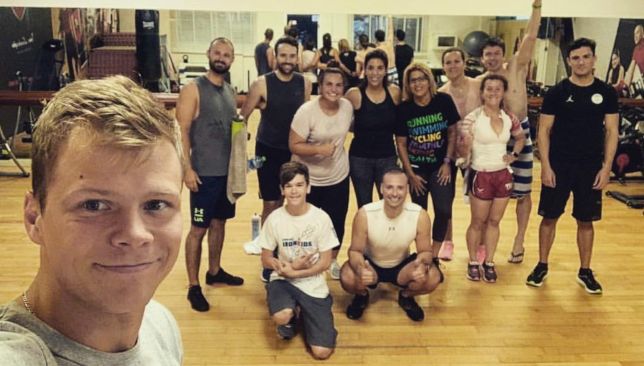
Sport360°’s Chris Bailey has signed up for the challenge of his life in November – an Ironman. Follow his adventure as he prepares his body for a 2.4-mile swim, 112-mile cycle and a marathon to finish … check out part 1 and part 2 if you haven’t already.
There really is nothing worse than sickness for an athlete – even a wannabe like me.
I had feared that my first experience of skiing would end with me sprawled somewhere down the mountainside having careered into a crevasse. Instead I spent half the holiday sprawled in bed, having careered into the flu.
It took me a week and a half to shake off the leech of a cough before I could simply train again, and such was my desperation to catch up that I launched myself into 12 back-to-back training days.
I Love Supersport Dubai coach Dmitriy – whom I hadn’t seen for much of March while on my travels/sickbed – was suitably unimpressed. But with 10 weeks to go until my first crack at an Ironman-branded event, Staffordshire 70.3 (half the distance of the real thing), I felt compelled to catch up.
Dmitriy gave me a reality check, complete with a few reminders. I had sprung my little jaunt-that-turned-sickly on him too soon, so communication was the first thing. Monitoring my resting heart rate, one of the best ways to assess fatigue, was another. We also arranged to check my bike set-up and lay the groundwork for my next block of training, which is designed to soup up my (meagre) strength.
HUSTLE AND MUSCLE
Think of triathletes and you certainly don’t think of rippling muscles bursting out of tiny lycra oufits (well, perhaps the lycra). In the ideal world, endurance athletes are streamlined, supple and possess vast reserves of stamina – with muscles seemingly superfluous in that equation.
Wrong. Triathlons stress the entire body. When your legs and arms are in motion, it’s your core, lower back, glutes et al that help maintain form and posture. Start flagging without the requisite training and you’re in danger of crumpling.
So with this knowledge in my armoury, I met coach Melina and ILSS’s other triathletes-in-training for a bright and breezy 6am start at Jebel Ali.
An hour with Melina, an experienced Ironman competitor herself, flies by. Just as well – the exercises are tough. But the fast-paced, no-nonsense circuit training allows little time to reflect on the aches as you move from exercise to exercise, swapping with your classmates.
There was the motivating feeling that we were all in this together – there’s a camaraderie at ILSS which is impossible to replicate at a standard gym class, let alone on your own.
I loved it so much (and because Dmitriy had me down for it), I attended Melina’s class twice in three days. Tired? Yes, but all the tauter for it.
Personally, the beauty of triathlon lies in the variety of the three disciplines and it feels like I’ve found a fourth. Is there a fifth? Ah yes, rest … the boring one. I’ll give it a go.
COACH’S CORNER
Dmitriy Firsov – ILSS coach
When Chris came to me for the first time, we had a few issues with swimming and endurance. Ever since, we have been working to improve technique and endurance base in all three disciplines. As of now we have finished the swim block and have moved on to the special endurance, more focused on bike and run, which takes up 80 per cent of the race.
The ‘check-up’ with a coach helps to monitor the condition of the athlete, identifying any issues (tiredness, pain etc) and helping to understand how to manage it. But the most important thing is to have a talk with your coach in the first place. Why? The coach can see the bigger picture in terms of your preparation and performance and even foresee some situations, if you share your feelings during or after training. I have a chat with each of my athletes at least once a week.
Being a coach is a lot of responsibility. It’s not just about putting together a training plan and giving advice – you are managing someone’s life on a daily basis. That’s why it’s very important to stay in touch all the time, understanding how the athlete lives, what’s his/her daily routine. Everyone has their own problems, needs and circumstances. Sometimes you have to be hard and give an extra push, but sometimes you just have to support your athlete.
Strength training is one of the main building blocks in triathlon. It helps us maintain a high level of performance and avoid injuries. Whatever discipline we train, our entire body is working. According to ‘Scientific Triathlon’, strength training improves a five-minute cycling time trial by seven per cent, and a five-minute running time trial by 4.7 per cent.
The tested group also showed a 5 per cent increase of v02 max. We recently started Chris on our specific I Love Supersport Triathlon strength endurance training, which are group sessions at Jebel Ali Recreation Club, so we are expecting a massive improvement from him in this area in the next few weeks.
The biggest mistake people make in triathlon is overestimating their own abilities. They like to push themselves to the limit, but it must be backed up by a strong body and mind. According to USA Triathlon research, 74 per cent of people who train without a coach receive an injury (lack of knowledge, overestimating their abilities, too little recovery etc). A coach can help you to stay healthy, strong and stay away from injuries.
I Love Supersport Dubai is the premier international endurance sports school. No matter your age or ability, achieve your goals as a swimmer, runner, cyclist and triathlete under the tutelage of some of the region’s best coaches. Visit dubai.ilovesupersport.com for more details.